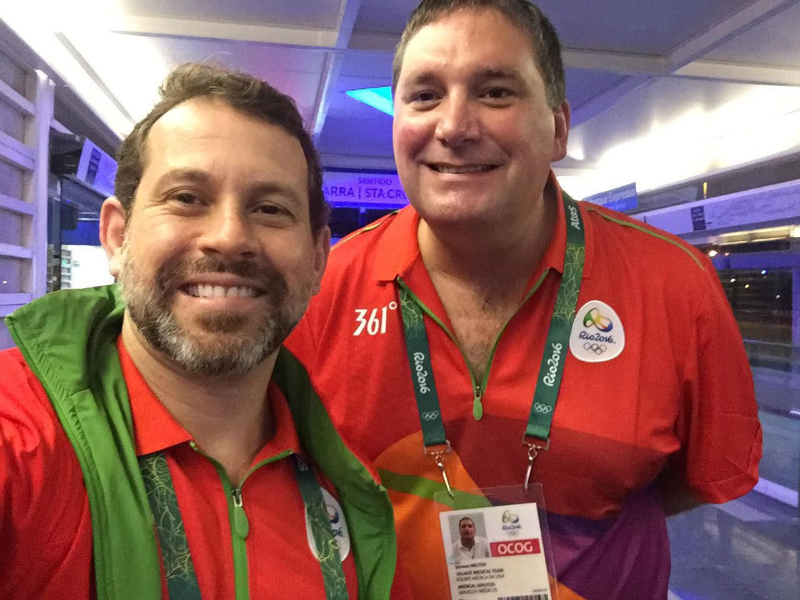Osteopathic Healthcare at the Olympic Games
As healthcare providers, osteopathic practitioners have contributed their clinical skills to athletes around the world for over a century. In 2016, the Osteopathic International Alliance (OIA) reached out to its member organizations and learned that more than 100 osteopathic physicians and osteopaths have served as health care providers to elite athletes, including ones who have won Olympic medals in the 1992, 1994, 1996, 2000, 2004 and 2008 Games.
In recent years, though, osteopathic practice has taken another step forward: it’s become an official part of two Summer Olympics. At the 2012 London Games, 25 international osteopaths staffed a clinic in the Athlete’s Village, making osteopathic treatment a healthcare option for all athletes. During the London event, osteopathic practitioners provided over 900 treatment sessions to athletes from eight countries and forty different sports. Additionally, osteopaths and osteopathic physicians worked behind the scenes, participating in London Olympic committees on operations, logistics, and personnel.
In 2016, the osteopathic community and the OIA built on that that success by setting our sights on the Rio Games. Building on the London experience, the Brazilian Register of Osteopaths (RBrO; an OIA Associate Member) formed the local Osteopathic Committee for the Rio 16 Olympic Games (Comitê Osteopático para os Jogos Olímpicos do Rio 16, or COJO), which was later superseded by volunteer consulting from RBrO.
The Brazilian group faced significant obstacles. In the United Kingdom, osteopaths are widely recognized and regulated; in Brazil, the same is not true. “[To] include only trained osteopaths within the medical services of the Olympic and Paralympic Polyclinic, in a country where the profession is not recognized and [is] also taken as a specialization [within] physiotherapy, was a huge victory,” says Jacson Nesi, a Brazilian osteopath and RBrO member who acted as an external volunteer consultant to the Olympic Games. Administrative hurdles meant the Brazilian-led cohort of osteopathic professionals was about half the size that London had enjoyed, with eight for the Olympics and six for the Paralympics.
Nonetheless, Brazilian osteopaths plus others from Japan and the United Kingdom teamed up to provide 1,100 osteopathic evaluation and treatment sessions in just 35 days. These included 700 treatments to Olympic athletes and about 400 to Paralympians.
The working environment was uniquely interdisciplinary. Osteopathic professionals often worked side-by-side with physiotherapists and chiropractors in a single kinesiotherapy clinic. “That was where we had our richest and most amazing experiences,” Nesi says.
He also singles out the Paralympics Games as an exceptional time. “The experiences with Paralympic athletes were indescribable. Whatever I say will never represent our true feeling. They were open, in a good mood, and always coming back to share their medals with us.”
Osteopathic physicians from the United States were also prominently engaged in the Rio Olympic Games. As chief medical officer for the International Shooting Sports Foundation, James L. Lally, DO, an osteopathic family physician from Chino, California, took responsibility for the health of nearly 400 Olympic shooting sports athletes. This was the sixth time Dr. Lally supported the Summer Olympics. In addition, Naresh Rao, DO, served as medical liaison for the U.S. water polo team; Rebecca Rodriguez, DO, ran an Olympic training center; and Jeff Anthony, DO, served onsite in Rio at the Paralympic Games, using osteopathic manipulative treatment to benefit athletes competing in sitting volleyball and wheelchair rugby.
The OIA’s Sports Care and Olympics Special Interest Group is already planning with Korean and Japanese colleagues for the upcoming Winter Olympic Games in Pyeongchang, Korea, in 2018, and the Summer Games in Tokyo, Japan, in 2020. The OIA hopes osteopathic physicians and osteopaths can continue to increase their contributions to Olympic and Paralympic athletes’ health, consistent with the Latin Olympic motto Citius, Altius, Fortius: “Faster, Higher, Stronger.”

Photo captions:
Top: RIO 2016 Olympic Medical Team
Bottom: Ronaldo Damasceno and Simeon Milton, Advisors for the Osteopathic Team.
